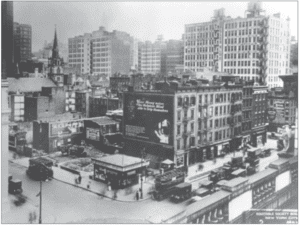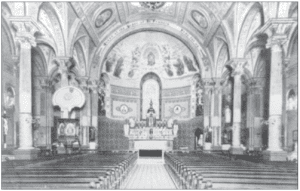Fr. Francis Koch’s pastoral sense and understanding of changing times was shared by his successor, Fr. Eusebius Schlingmann, O.F.M., who led St. Francis of Assisi as Pastor from 1903 to 1907. On the first anniversary of the Nightworkers’ Mass in 1905, Archbishop John M. Farley wrote the following letter to Fr. Eusebius:
I am pleased to hear of the success attending the half-past two A.M. Sunday Mass at St. Francis Church. Among the many things which I had to communicate to the Holy Father and which he assured me was a great consolation to him, was the request of the night workers in your neighborhood to have Mass at half-past two o’clock on Sunday mornings, to enable them to comply with the duty of hearing Mass. He desired me in the most affectionate manner to convey to yourself and to all those good and zealous Catholics who at such inconvenience comply with the precept of the Church by assisting at that early Mass his apostolic benediction, which I hereby empower you to bestow on that congregation on Easter morning. Praying for you and for them every blessing and all Easter joys, I am Sincerely yours in Christ,
+John M. Farley, Archbishop of New York
Fr. Eusebius also asked permission for a Mass at noon during Lent. The first midday Mass was offered on Ash Wednesday, February 13, 1907. In the Catholic News of that day, Fr. Eusebius wrote:
“For several year past I have been thinking of celebrating Mass at high noon. I have noticed very many people in the church at this hour every day of Lent, making a visit or saying the Stations. Even if only forty or fifty people could hear Mass at that hour who otherwise would be deprived of that blessing, we should feel amply repaid for the sacrifice.”
The noon Mass attracted such crowds that it was decided to continue the Mass on a daily basis. The Church of St. Francis of Assisi was the first church in the United States to have a daily Mass as late as 12:15 P.M., and the little church on 31st Street became known as a convenient spiritual oasis for busy travelers, shoppers and workers.
Grand hotels began to appear in the neighborhood, and visitors to New York found the church convenient and uplifting. In 1910 the Pennsylvania Railroad Station became a main terminal on the corner of 7th Avenue, and travelers began to worship and pray in the beautiful St.Francis Church. Department stores and businesses in the neighborhood were booming, and shoppers and workers found the church a warm welcoming spiritual center. St. Francis Parish had few remaining parishioners, but thousands of devotees were finding their way to the Franciscan church between 6th and 7th Avenues. The attractive sanctuary developed into a Service Church for the people, a new model of urban ministry.
Fr. Eusebius managed to pay off the remaining debt on the church. In the space of four short years he raised $52,000. During those years attendance at Mass had triples, and the number of people at devotions continued to increase. Fr. Eusebius reconstructed the church school, and raised its standards to such a degree that in 1906 the pupils won first prize for being the best of all parochial schools in New York City.

In this photo, taken from atop Pennsylvania Station in the 1920’s, shows the neighborhood surrounding St. Francis Church (seen in the upper left).

The earliest photo of the interior of the present church, shows the central window in the apse directly behind the altar before the installation of the Great Mosaic in the 1920’s. That window, St. Francis in Glory, can now be seen in the 31st Street vestibule of the church.
This series of articles on the history of our parish is adapted from the writ- ings of Fr. Flavian Walsh, O.F.M., Pastor from 1985-87.

